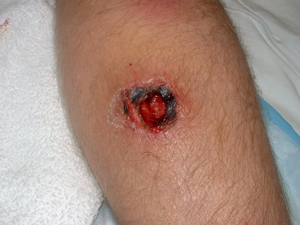
Drug resistant Staph much more common in last few years
For 25-30 percent of the human population, Staphylococcus aureus
bacteria live on the skin without causing any problems. But for
some the bacteria can cause skin infections, blood disease or even
pneumonia and at its worst can be fatal. A new strain of Staph
bacteria that has developed in recent years is immune to the go-to
treatment
– Methicillin.
Drug resistant Staph much more common in last few years
For 25-30 percent of the human population, Staphylococcus aureus bacteria live on the skin without causing any problems. But for some the bacteria can cause skin infections, blood disease or even pneumonia and at its worst can be fatal. A new strain of Staph bacteria that has developed in recent years is immune to the go-to treatment – Methicillin.
“It has undergone some changes that made it – a protein or factor that it acquired – makes it 700 times more invasive than Staph 10 years ago,” said Peter Coelho, a Hollister family practitioner. “People call with a spider bite and it’s almost never a spider bite.”
Staph bacteria cause a skin infection that can look like a pimple or a boil that is red, swollen or painful.
“If they develop more than one, they need to see a doctor right away,” Coelho said. “Even one that is growing over a couple days and getting worse is most likely going to be Staph.”
With the increase in cases of MRSA – Methicillin-resistant Staphylococcus aureus – the state of California Public Health Department staff have made it mandatory that doctors report severe cases.
“Over the past few years we started to receive information from hospitals of this particular infection,” said Elizabeth Falade, the health officer for San Benito County. “We found bugs we were able to treat easily became resistant to therapy. A lot of hospital-acquired infections where drugs and bugs are in the same environment become accustomed to the drugs.”
The San Benito County Public Health Division sent out a notice Feb. 19 to local physicians and medical centers. Staph infections have often been associated with people who have been hospitalized, especially after a surgery or major trauma, but the number of cases in the general population among healthy people has gone up. According to the Centers for Disease Control and Prevention, about 14 percent of MRSA cases in a study of several major cities in 2005 had no exposure to healthcare. For now just severe cases need to be reported to the Public Health Division.
“Just those who get MRSA in the community who have not been in a nursing home or hospital,” Falade said, “who come down with some kind of infection, bladder or a bad skin infection or pneumonia, in those cases where a person dies or is hospitalized in the intensive care unit.”
Coelho, a local doctor who has treated Staph, said athletes and people who attend the gym are likely to be exposed to the bacteria.
“Wrestlers especially, football players,” Coelho said. “Those who wear tight clothing or don’t regularly change their athletic gear. They get it off surfaces others were sweating on.”
Both Coelho and Falade suggested some tips for athletes or people who attend a gym regularly.
“It’s skin-to-skin or skin-to-skin through an intermediate so it is something you might encounter at a gym on the seat riding a bicycle,” Falade said.
The main thing people can do is practice good hygiene by washing their hands regularly or showering after exercise on shared sports equipment. They should also keep any cut or lesion covered with dry dressings, Falade said. If they are going to a gym or pool, they should keep personal items such as towels or clothing to themselves.
“If you sit on or use equipment, put some kind of barrier between your skin or the equipment,” Falade said. “One would expect the gym [staff] is doing whatever they need to be doing, but it never hurts to be extra safe.”
Avoid the spread of Staph infections
Cover your wounds – Keep wounds that are draining or have pus covered with clean dry bandages.
Clean your hands – You, your family and others in close contact should wash their hands frequently with soap and warm water or use an alcohol-based hand sanitizer.
Do not share personal items – Avoid sharing personal items such as towels, washcloths, razors, clothing, or uniforms that may have had contact with the infected wound or bandage. Wash sheets, towels, and clothes that have become soiled with water and laundry detergent. Dry laundry in a hot dryer.
Talk to your doctor – Tell any healthcare provider who treats you whether you have had a Staph or MRSA skin infection in the past.
Courtesy of the San Benito County Health and Human Services Agency Public Health Division









